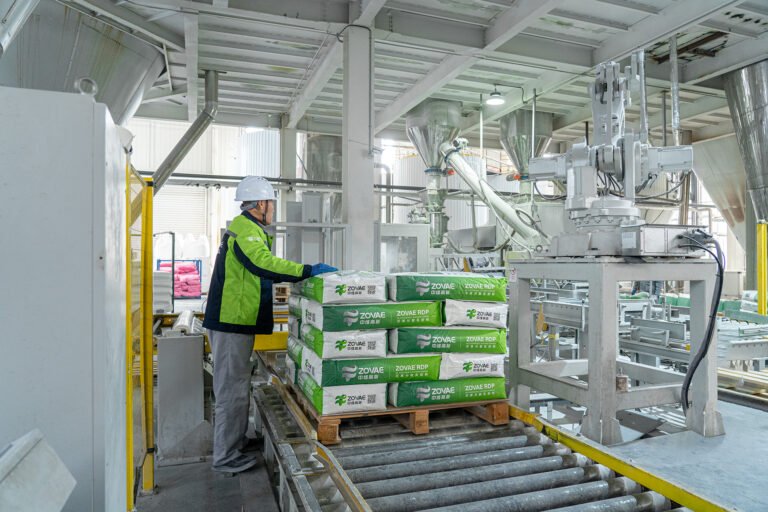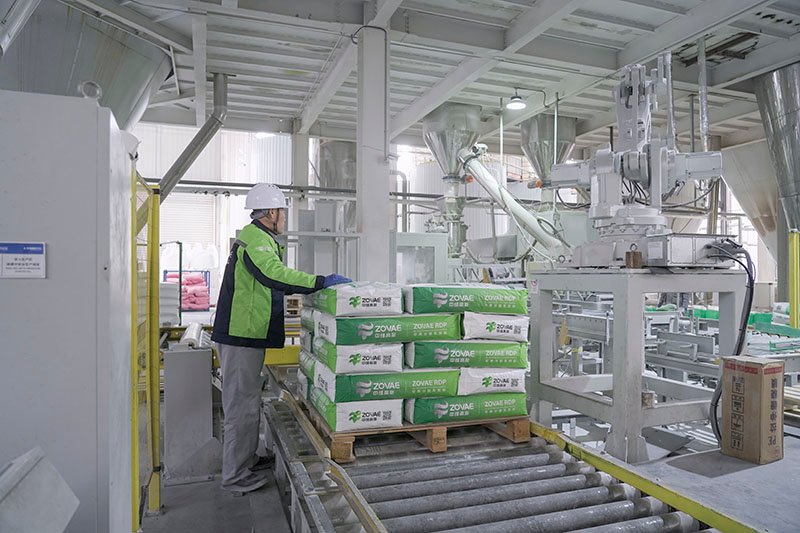
Merry Christmas ZOVAE
Wishing You Joy & Prosperity
Executive Summary
Redispersible polymer powder (RDP) elevates dry-mix mortars from basic mineral composites into advanced materials that attach more securely, bend without breaking, and withstand environmental challenges like moisture and temperature fluctuations. Created through spray-drying a stabilized polymer suspension—typically vinyl acetate–ethylene (VAE) types—RDP scatters quickly upon hydration, subsequently merging into a seamless polymer layer during the mortar’s hardening phase. This layer connects mineral elements and bases, boosts attachment, refines unity and usability, and customizes adaptability, moisture opposition, and longevity to suit specific tasks. Variants with hydrophobic modifications additionally curtail capillary liquid intake and bolster resistance to freezing-thawing cycles.
When applied thoughtfully, RDP yields three primary results in dry-mix mortar: superior attachment and environmental endurance; amplified adaptability and shock opposition; and diminished substance liquid absorption. This overview delves into the granule- and structure-level operations underpinning these gains; details how to pick RDP variants based on glass-transition levels (Tg), minimal layer-creation temperatures (MFFT), and stabilizing agents; and offers blending frameworks, measurement spans, blending procedures, quality oversight markers, and diagnostic advice for slab attachments, exteriors and coatings, thin layers, EIFS base layers, repair binders, stonework binders, and self-leveling bases (SLU). It further addresses weather and base adjustments, economic value and eco-friendliness, wellness and preservation, and a hands-on rollout framework with illustrative examples. The objective is trustworthy, consistent site efficacy with scarcer imperfections, reduced revisions, and an improved applicator encounter.
What makes RDP a game-changer in an industry grappling with sustainability and performance demands? By bridging traditional mineral rigidity with polymer versatility, it enables mortars that not only meet but exceed modern standards, reducing waste and extending infrastructure life.
1) What Redispersible Polymer Powder Is and How It Operates
RDP represents a spray-dried form of an aqueous polymer suspension. In its powdered state, stabilizing agents—often polyvinyl alcohol (PVOH)—maintain the polymer granules as a freely moving dust. Upon contact with liquid, the stabilizing mechanism breaks down, and the polymer re-scatters to reform a fine latex-resembling suspension. Within fresh mortar, this suspension moistens cement and bulk exteriors, bolsters unity, and eases spreading. As curing progresses, with liquid vaporizing and cement reacting, polymer granules merge (beyond MFFT) into a seamless layer that:
These operations work in concert with the overall blend. Cellulose derivatives (HPMC/MHEC) oversee moisture hold and flow traits, fostering even polymer spread and layer development. Harmonious defoamers maintain trapped gas at desired levels, maximizing actual contact zones and robustness. Flow enhancers (PCE) cut liquid needs and aid in achieving movement at lower liquid/cement proportions, while RDP sustains unity and transfer at those reduced proportions.
Historically tracing back to mid-20th-century innovations in polymer chemistry, RDP evolved from liquid latex limitations, offering dry storage stability and easy integration into powder blends. Today, it addresses contemporary challenges like high-SCM cements, where it ensures hydration without sacrificing performance. For example, in a high-rise facade, RDP’s layer acts like an internal shock absorber, distributing stresses and preventing delamination over decades of exposure.
Moreover, the operations adapt to environmental factors: in humid settings, rehydration is swift; in arid ones, controlled moisture via cellulose prevents premature drying. Consequently, RDP not only modifies physical traits but also enhances process reliability, making it indispensable for scalable production. We have Flexible RDP, Rigid RDP, Semi-Flexible RDP, and Self-Leveling RDP to meet your application needs.
2) The Three Top Advantages in Depth
2.1 Superior Attachment and Environmental Endurance
Operation
Results
Refinement
Where It Counts Most
In contrast to unmodified mortars, RDP-enhanced versions can withstand aggressive weathering, as seen in coastal projects where salt-laden air accelerates corrosion—here, the polymer barrier shields without impeding breathability.
2.2 Amplified Adaptability and Shock Opposition
Operation
Results
Refinement
Where It Counts Most
Consider a bridge deck repair: without RDP’s adaptability, vibrations could propagate cracks; with it, the mortar flexes like a resilient joint, extending the structure’s service without frequent interventions.
2.3 Diminished Liquid Absorption with Water-Repellent Types
Operation
Results
Refinement
Where It Counts Most
This advantage shines in regions with high rainfall, where unmodified mortars might saturate and fail; RDP transforms them into barriers that repel while allowing vapor escape.
3) RDP Variant Choice: Aligning Polymer to Efficacy
3.1 Polymer Molecular
3.2 Tg and MFFT
3.3 Stabilizing Agent System
3.4 Granule Size Spread and Residue
3.5 Water-Repellent Adjustment and Linking
4) Usage-by-Usage Blending Frameworks
The measurement spans below are initial; refine via lab and field.
4.1 Slab Bonding Agents (Thin-Set; Oversized; Upright Non-Droop)
Aims
Initial Blend Spans (by Dry Blend Mass)
Validation and Efficacy Checks
4.2 Exteriors and Coatings (Cement/Lime; Outdoor; Indoor)
Aims
Initial Blend Spans
Validation and Efficacy Checks
4.3 Thin Layers and Surface Fillers (Cement- or Plaster-Based)
Aims
Initial Blend Spans
Validation and Efficacy Checks
4.4 ETICS Base Layers (Bonding + Base with Mesh)
Aims
Initial Blend Spans
Validation and Efficacy Checks
4.5 Repair Binders and Stonework Binders
Aims
Initial Blend Spans
Validation and Efficacy Checks
4.6 Self-Evening Bases (SLU)
Aims
Initial Blend Spans
Validation and Efficacy Checks
5) Blending and Operational: Procedures for Plant and Site
Dry Mixing
Wet Blending
Agitation and Gas Oversight
Hardening and Weather
6) Quality Oversight: From Received RDP to Hardened Efficacy
Received RDP Checks
Fresh Binder Assays
Hardened Binder Assays
7) Harmony and Collaboration with Other Enhancers
Cellulose Derivatives (HPMC/MHEC)
Starch Derivatives
Flow Boosters (PCE)
Repellents (agents)
Fibers and Bulks
8) Diagnostics Guide
Sign: Poor Attachment Post-Liquid or Freezing-Thawing
Sign: Collapse or Slip on Uprights (Bonding Agents/Exteriors)
Sign: Exterior Voids or Pits
Sign: Rigid Layer or Early Fine Fracturing
Sign: Excess Gas/Low Wet Compactness; Reduced Robustness
Sign: Clumping in Preservation or Poor Rehydration
9) Weather, Base, and Seasonal Tuning
Hot, Arid Weathers
Cold, Humid Weathers
High-Intake Bases
Dense, Low-Intake Bases
10) Eco-Friendliness and Economic Value
RDP aids eco-friendliness and lifecycle worth by:
Economic Considerations
11) Wellness, Management, and Preservation


12) Illustrative Examples
Example 1: Outdoor Exterior in Hot, Windy Area
Issue: Early crusting, fine fractures, inconsistent attachment to blocks.
Action: Switched to lower-Tg repellent VAE RDP at 2.5% to 3.5%; slightly upped cellulose for open; added screens to cut wind.
Result: Open extended minutes; fracture down markedly; pull-off post-cycling improved; uniformity up.
Example 2: Oversized Porcelain Slab on Upright Facade
Issue: Ridge collapse and slippage; low transfer to dense backs.
Action: Upped RDP from 3.0% to 5.5%; added starch for recoverability; optimized defoamer; trained on angle/pressure.
Result: Non-droop met limits; transfer uniform; tested attachment improved across cycles.
Example 3: Thin Layer with Persistent Voids
Issue: Small-foam leading to abrading and redo.
Action: Introduced harmonious defoamer earlier; cut late high-agitation; kept RDP at 2.0% while upping retention for even drying.
Result: Void count near zero; smoother with less time.
Example 4: ETICS Base Layer Shock Failures
Issue: Reinforced base fracturing and poor opposition in cold.
Action: Shifted to lower-MFFT RDP at 4.5%; adjusted fiber; implemented controlled hardening.
Result: Opposition improved; bridging enhanced; winter window expanded.
13) Rollout Framework
Outline Goals
Select Candidates
Simulate Weather
Lock Procedures
Scale and Validate
Monitor and Refine
14) Common Queries
Q: Can RDP replace liquid latex fully?
A: In most dry-mix, yes—logistics edges (dry mixing, no freeze, stable preserve) and comparable when optimized. Some specialty may use liquid; evaluate.
Q: How does RDP interact with cement reaction?
A: Selected RDP avoids inhibiting at typical measures. It modifies structure and aids moisture; hold primarily by cellulose.
Q: Will more RDP always better efficacy?
A: To a point. Excess can reduce firmness, up cost, affect upright grip. Find minimal effective for targets under weathers.
Q: Does RDP amp gas introduction?
A: RDP and stabilizers can influence foam. Manage with harmonious defoamers and blending; verify compactness/gas and adjust.
Q: What if layer creation impaired in cold or arid?
A: Use lower-Tg/MFFT RDP, extend open with cellulose, protect from wind/sun, maintain moisture during early.
15) Conclusion
Redispersible polymer powder transforms dry-mix binders into robust, applicator-friendly setups that attach better, bend rather than fracture, and oppose liquid and weather. At granule level, rehydration and merging produce seamless polymer layer that links boundaries and strengthens mineral framework. At site, that layer converts to measurable gains: higher fresh and tested attachment, enhanced adaptability and shock opposition, and reduced liquid absorption—especially with repellent types. Success hinges on matching RDP type to weather and usage, balancing measure with moisture hold and flow, controlling gas and blending energy, and validating with disciplined oversight. Follow blending frameworks and rollout here, and convert RDP’s molecular into reliable, repeatable site efficacy with scarcer imperfections, less revisions, and longer usability.
If you share binder type, target markers (open, droop, compactness/gas, attachment fresh/tested, capillary absorption), weather/base outline, and issues (voids, slippage, short open), we can suggest 2-3 RDP types, measure spans, and concise assay plan tailored to goals.


Please leave your contact information, and Zovae’s sales team will provide you with dedicated service.
